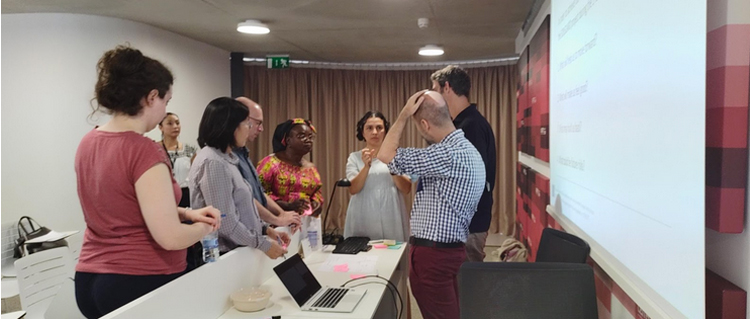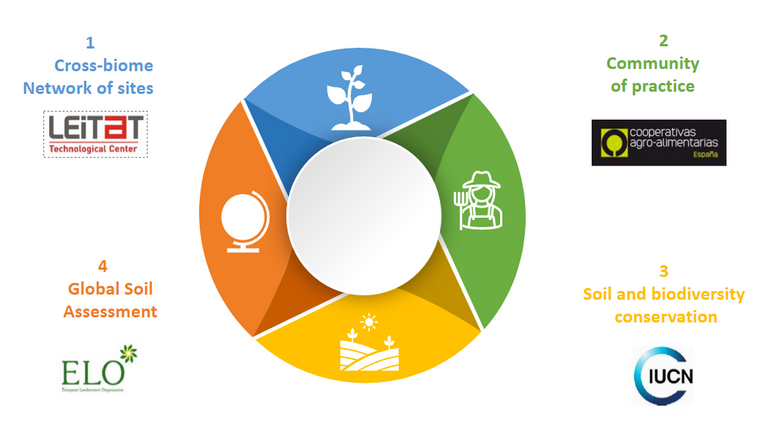The SNoK is the space where the co-production of knowledge is developed within SOILGUARD and aims to reach the highest level of application of Nature’s Contribution to People (NCP) practices to conserve soil biodiversity and its functions.
The SNoK starts with the SOILGUARD partners and evolves by integrating a variety of stakeholders during the project such as Academia, Biodiversity Networks, Farmers, Landowners, Agricultural sector, Policy makers, Community leaders, National laboratory for Soil Science and Relevant Government Agencies and Intergovernmental Organizations, such as the Global Soil Partnership (GSP) and the Global Soil Biodiversity Initiative (GSBI), in order to contributes to increase the potential of the Soil Biodiversity and Wellbeing Framework (SBWF) to become the future global standard to assess soil biodiversity and its importance for the planet and human wellbeing.
The SNoK will help to co-validate and promote the SOILGUARDIANS app, one of the main outputs of the project, which will become the common platform for knowledge sharing, with SNoK members being the initial users.
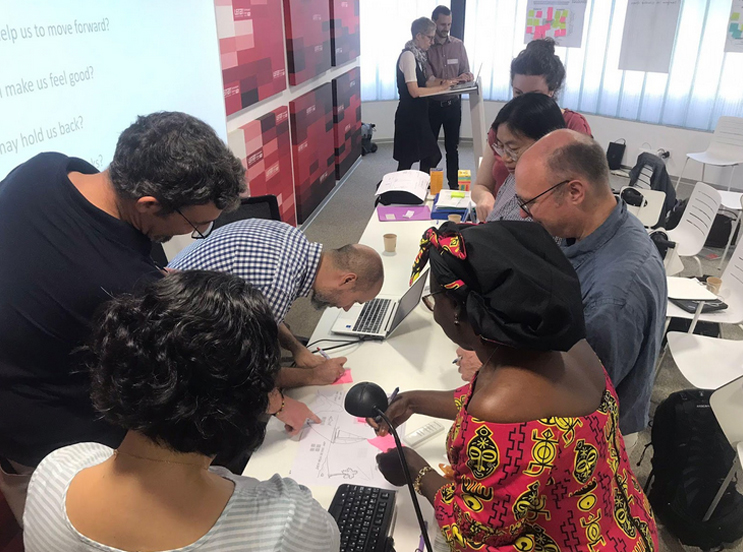
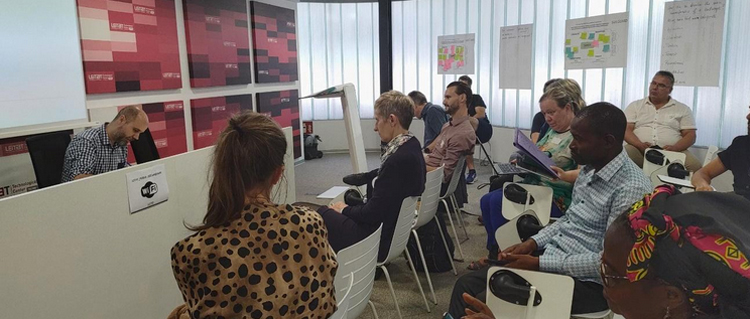
From the outset the SNoK follows an inclusive, gender-sensitive, problem-oriented, multi-actor and multi-level approach (based on transdisciplinary research, TDR).
The involvement of multiple soil-related stakeholders (multi-actor and multi-level approach) to ensure co-creation, empowerment and co-ownership of the results is considered essential, and that is why transdisciplinary research (TDR) is desired in SOILGUARD as a general approach to follow.
TDR refers to research approach that tackles real life problems, addresses the complexity of problems by involving a variety of actors and creates knowledge that is transferable to both scientific and societal practice (Pohl and Hirsch Hadorn 2007, Lang et al. 2012).
Regarding the creation of knowledge, in the TDR the knowledge is co- produced, which means that a joint production of knowledge is generated between experts from different disciplines, sectors, and decision levels, including joint problem formulation, knowledge generation, application in both scientific and societal practice, and mutual quality control of scientific rigor, social robustness, and practical relevance (Polk, 2015).
Research activities, individual programs and projects are increasingly involving a diversity of actor groups to deal with the complexity, ambiguity, and uncertainty of the sustainability problems that we faced at the present (Adler, et al., 2009). TDR is often applied to projects which aim to address these wicked problems. This approach transcends disciplinary boundaries and bridges between science and practice. Then, TDR is intended to create a more comprehensive understanding of sustainability related problems and develop practice-oriented solutions to deal with them (de Jong, et al., 2016; König, et al., 2013; Jahn, et al., 2012; Pohl & Hirsch Hadorn, 2008; Polk, 2014).
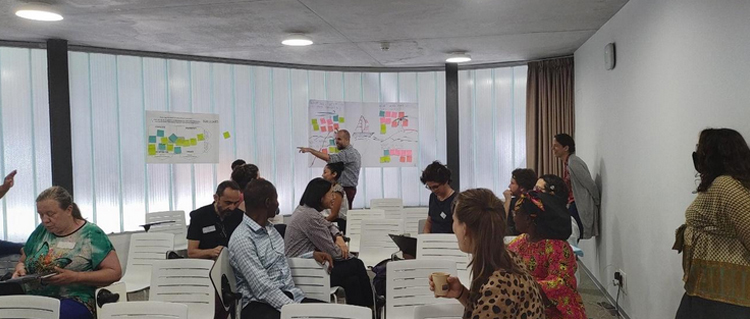

The Action Groups (AG) are four: 1- Cross-biome Network of Sites, 2- Community of Practice, 3- Soil Biodiversity Conservation and Policy recommendations, and 4- Global Soil Assessment Initiatives (see Figure 2) .
The main objectives of each group are framed in general terms as follows:
- Cross-biome Network of Sites is focused on understanding the status of Soil Biodiversity and its contribution to multiple soil-based ecosystem services, such as biomass production and carbon sequestration.
- Community of Practice targets the establishment of a community to conserve biodiversity and avoid soil degradation, and it also focuses on the discussion regarding the importance of ES and the success of region-specific SSM.
- Soil Biodiversity Conservation and Policy recommendations, addresses those recommendations aiming to produce science-based recommendations on soil management, policy, and conservation, as well as recommendations are discussed by policy makers and other stakeholders.
- Global Soil Assessment Initiatives aims to consolidate effective linkages between SOILGUARD and key initiatives in soil management and biodiversity worldwide through specific strategic activities and networking form the outset.
Figure 2 Figure 3 SNoK and Action Groups
1. Cross-biome Network of Sites
AG1 is focused on understanding the current status of Soil Biodiversity and its contribution to multiple soil-based ecosystem services, such as biomass production and carbon sequestration. This will be performed at a global scale, by defining Soil Biodiversity and Soil Multifunctionality across a network of 200 sites belonging to 10 different countries. The specific objectives of this action group are:
- To co-validate and harmonize soil sampling protocols for soil biodiversity and multifunctionality assessment.
- To define soil biodiversity status and soil multifunctionality on each site.
- To create a network among them, the cross-biome network of sites.
Specifically, SOILGUARD aims to go beyond science-driven research and incorporate insights from innovation and problem-driven science, putting social innovation into the action. Engagement of different actors as farmers, landowners, cooperatives, and scientists will contribute to tackle the AG1 objectives. The level of engagement desired in this AG is the consultancy/participatory.
2. Community of Practice
AG2 targets the establishment of a Community of Practice to conserve biodiversity and avoid land degradation. It also focuses on the discussion regarding the importance of multiple environmental services, ES, and the success of region-specific Sustainable Soil Management practices, SSM, to conserve soil biodiversity and maximize soil multifunctionality.
The main objective of AG2 is related to promote the co-creation process within the community of practice, needed to:
- Co-validate the evidence chains that integrate the different dimensions of the project to portray region-specific benefits and potential trade-offs/synergies between soil natural capital, soil-related ES and societal wellbeing in different socio-ecological contexts.
- Co-develop the SOILGUARDIANS app.
In this sense, AG2 particularly emphasizes the engagement of farmers, landowners, and cooperatives in a collaborative manner.
3. Soil Biodiversity Conservation and Policy recommendations
AG3 will address Soil Biodiversity Conservation and Policy recommendations aiming to produce science-based recommendations on soil management, policy and conservation at a time those recommendations are discussed by policymakers and other relevant stakeholders. The approach is to understand the Soil Biodiversity and its sustainable soil management as a Nature Based Solution.
The level of engagement required from the stakeholders will be collaborative, focused on the understanding of present barriers for policy implementation and the co-creation and co-validation of the recommendations produced. It will be involved in the provision of support to relevant Member State commitments under the Global Soil Partnership and on the implementation of the soil related policies of the European Green Deal.
Under this AG, the encouragement of investment, technical cooperation, policy, education, awareness and extension in soil and the harmonization of methods, measurements and indicator for the sustainable management and protection of soil resource.
4. Global Soil Assessment Initiatives
AG4 aims to consolidate effective linkages between SOILGUARD and key initiatives in soil management and biodiversity worldwide through specific strategic activities and networking from the outset. The stakeholders reached by this group are the academia, soil and biodiversity networks (e.g., GSP, IPBES, GSBI, Soil BON, ITPS, Ecosystem Service Partnership, Global Soil Crop Microbiome and the Global Forestry Biodiversity Initiative), FAO, JRC and other joint initiatives and similar projects.
The objective of AG4 is to create and maintain alliances with different soil initiatives worldwide, maximizing joint initiatives and collaborative activities and harmonizing methods, measurements, and indicators. It is key to allow existing networks to work together and to give the different networks the ability to increase their impact and ensure the visibility of their contributions. Strengthening network partners’ engagement and reaching out to potential new partners, building on examples of existing networks, etc. all contribute to the goal of harmonizing methods, measurements, and indicators for sustainable soil management. As engagement with such networks grows, increased stakeholder groups become involved from relevant fields and sectors.
Then, AG4 focuses on global soil assessment initiatives as the State of the Global Soil Biodiversity report by FAO.
The SNoK will be the space to co-create and co-implement the Engagement Strategy and SBWF (integrate link of the SP document and framework).
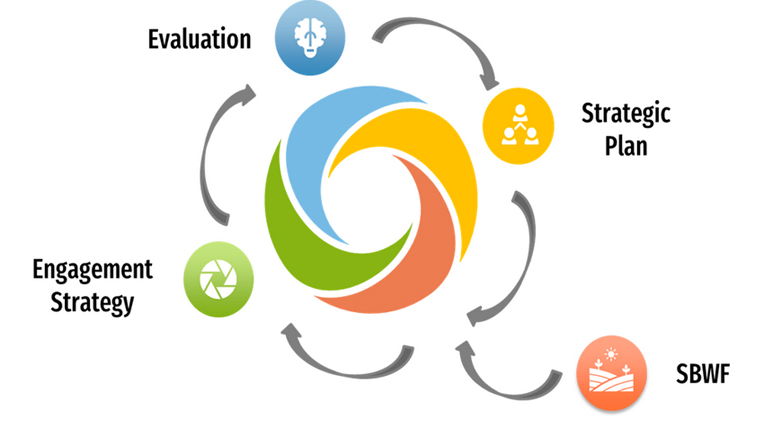
The methodology applied in the SNoK and co-creation of SP will be established to achieve the objectives established within the SOILGUARD project framed in Table 1, this table describes the key objectives of SOILGUARD, the main purpose and results, and the WPs and their relationship with the outcomes.
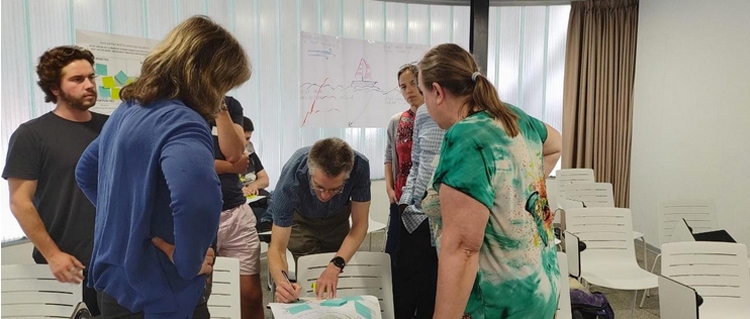
Key objectives |
Main Purpose |
|---|---|
| Addressing major knowledge gaps related to biodiversity and soil-mediated ecosystem services. | Creating the evidence to fill the gaps of knowledge and quantify the environmental, economic, and social consequences of unsustainable soil management. |
| Co-create a conceptual and analytical framework with the potential to become the global standard for future assessments of soil biodiversity status and its contribution to soil multifunctionality and human wellbeing. | This framework will be validated in an innovative experimental design, combining multiple study sites across biomes and regional land degradation gradients with in-situ climate change simulations. |
| OUTCOMES | |
| Main outcomes | WPs related to the outcome |
| i) All knowledge co-created will be shared through SOILGUARDIANS, a predictive tool based on the causal links between soil biodiversity, soil multifunctionality and wellbeing to support stakeholders on the transition to sustainable management. |
WP1 SOILGUARD Network of Knowledge WP2 Soil Biodiversity status and soil Multifunctionality WP3 The impact of climate stressors on soil biodiversity and soil multifunctionality WP4 Valuation of soil-mediated ecosystem services WP5 Prediction of soil-mediated ecosystem services delivery, value and wellbeing based on soil biodiversity |
| ii) The SOILGUARD’s network of knowledge and the connectivity enabled by SOILGUARDIANS app will create an ecosystem of innovation for users to showcase, learn and share experiences. |
WP1 SOILGUARD Network of Knowledge WP4 Valuation of soil-mediated ecosystem services WP5 Prediction of soil-mediated ecosystem services delivery, value and wellbeing based on soil biodiversity |
| iii) SOILGUARD will co-create evidence-based conservation recommendations for policies and frameworks at EU and international level and will support Member States commitments under the Global Soil Partnership. |
WP1 SOILGUARD Network of Knowledge WP6 Conservation of soil biodiversity |
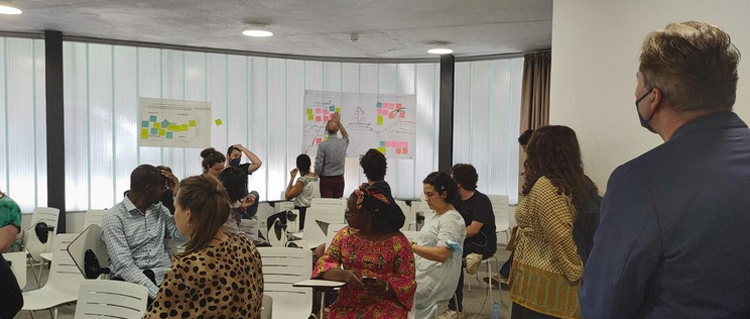
The objectives from the SOILGUARD Engagement Strategy are:
- Obtain a holistic picture of the state of soil biodiversity in relation to three major challenges: land degradation, unsustainable soil management and climate change.
- Co- create an experimental design focused on understanding the specific benefits of SSM in the region for conserving soil biodiversity and delivering soil-mediated ecosystem services under current and future environmental conditions.
Achieve a level of engagement between farmers, landowners, cooperatives, and scientists, among others, that is participatory and starts on the problem definition and data collection.
